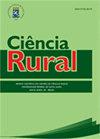有和无神经症状犬抗刚地弓形虫和犬新孢子虫抗体
IF 0.9
4区 农林科学
Q3 AGRONOMY
引用次数: 0
摘要
摘要:本研究调查了巴西南马托格罗索州坎波大地区犬的神经症状及可能的危险因素与刚地弓形虫和犬新孢子虫血清感染的关系。在本研究中,根据狗是否存在神经症状分为两组(每组n=30)。采用间接荧光抗体试验进行血清学诊断。在神经系统疾病组中,23.3%和30%的狗有抗t抗体。弓形虫和抗n。分别是犬抗体。此外,该组中有三只狗同时感染了这两种原虫。在无神经症状组中,弓形虫和犬奈瑟菌血清阳性分别为16.7%和13.3%。虽然出现神经系统体征与弓形虫和犬奈虫感染无关(P = 0.747和P = 0.21),但在有神经系统体征的犬中,弓形虫血清阳性与周围神经系统改变有统计学关联(P = 0.016)。生肉摄入是唯一与抗n存在相关的危险因素。犬抗体(P = 0.041)。结果显示犬暴露于犬奈瑟菌和刚地弓形虫的证据,无论是否存在神经症状。此外,本研究强调有必要对周围神经系统紊乱和不提供生肉的狗进行弓形虫血清学调查,以避免感染犬弓形虫的风险。本文章由计算机程序翻译,如有差异,请以英文原文为准。
Anti-Toxoplasma gondii and anti-Neospora caninum antibodies in dogs with and without neurological signs
ABSTRACT: This study investigated the association between neurological signs as well as plausible risk factors and the seroprevalence of Toxoplasma gondii and Neospora caninum infection in dogs of the Campo Grande region of Mato Grosso do Sul, Brazil. In this study, the dogs were divided into two groups based on the presence and the absence of neurological signs (n=30 in each group). Serological diagnosis was performed using the indirect fluorescent antibody test. In the group with neurological disorders, 23.3% and 30% of the dogs had anti-T. gondii and anti-N. caninum antibodies, respectively. Moreover, three dogs from this group showed co-infection with both protozoa. In the group without neurological signs, 16.7% and 13.3% of the dogs were seropositive for T. gondii and N. caninum, respectively. Although presence of neurological signs was not associated with T. gondii and N. caninum infections (P = 0.747 and P = 0.21, respectively), there was a statistical association between T. gondii seropositivity and peripheral neurological alteration (P = 0.016) among dogs with neurological signs. Raw meat ingestion was the only risk factor associated with the presence of anti-N. caninum antibodies (P = 0.041). Results revealed evidence of exposure to N. caninum and T. gondii in dogs irrespective of the presence of neurological signs. Moreover, this study highlighted the need for serological investigation of T. gondii in dogs with disturbances in peripheral nervous systems and not offering raw meat to animals to avoid the risk of N. caninum infection.
求助全文
通过发布文献求助,成功后即可免费获取论文全文。
去求助
来源期刊

Ciencia Rural
AGRONOMY-
CiteScore
1.70
自引率
0.00%
发文量
233
审稿时长
2-4 weeks
期刊介绍:
The purpose of Ciência Rural is to publish the results of original research, note and reviews which contribute significantly to knowledge in Agricultural Sciences. Preference will be given to original articles that develop news concepts or experimental approaches and are not merely repositories of scientific data. The decison of acceptance for publication lies with the Editors and is based on the recommendations of Editorial Comission, Area Committee and/ or ad hoc reviewers. The editors and reviewers are external to the institution.
 求助内容:
求助内容: 应助结果提醒方式:
应助结果提醒方式:


